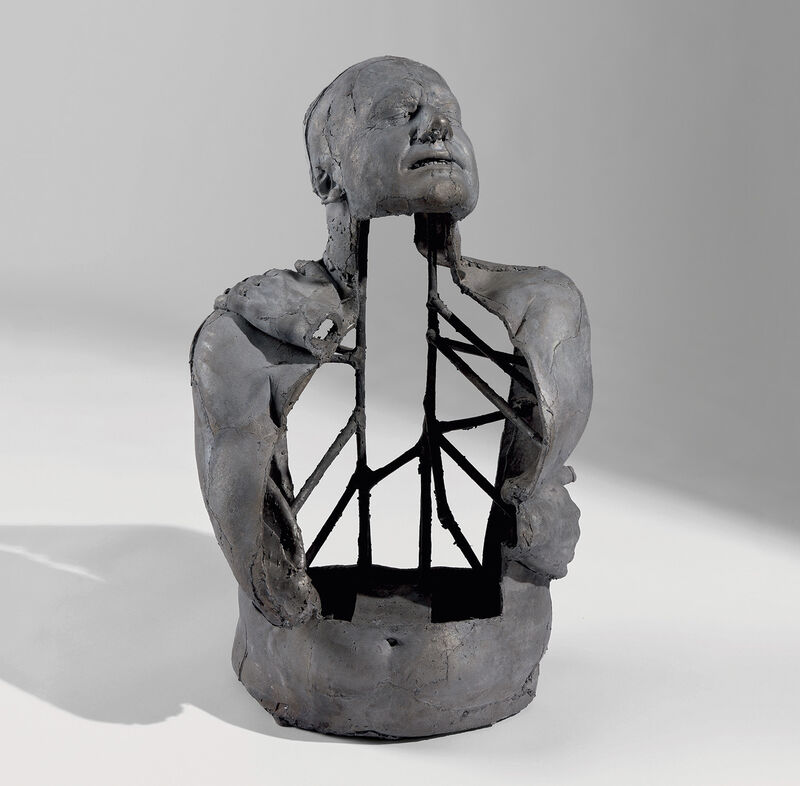
Life in Stasis: "Self" as a Testament
One of Quinn's most renowned works, "Self" (1991), encapsulates both themes seamlessly. This frozen sculpture of the artist's head, crafted from his own blood, is a stark reminder of life's fragility. It's a bold confrontation with mortality, presenting the very essence of life (blood) in the grip of death's inevitability (frozen state). Given its material and concept, "Self" was undoubtedly sensational. Some critics and audience members were shocked, finding it macabre or unsettling. The idea of preserving one's own blood in a self-portrait was seen as both audacious and eerie.Many art critics and scholars recognized the deeper layers of meaning within the piece. They viewed "Self" as a poignant meditation on mortality, identity, and the transient nature of life. Given that the sculpture needed to be constantly refrigerated to maintain its form, it also became a metaphor for the fragility of human existence. From a technical perspective, the craftsmanship involved in creating such a sculpture was acknowledged. The fact that Quinn repeated this process every five years, using a mold of his face and ten pints of his blood, showcased a dedication to exploring the evolution of self and identity over time. In the art market, "Self" garnered significant attention and achieved considerable commercial success. Charles Saatchi, the famous art collector and advertiser, was one of its early admirers and purchased it. The artwork's value appreciated over the years, reflecting its status in contemporary art circles.

Impermanence of the Human Form
Quinn often employs materials that are transient, like frozen flowers or melting wax. Such mediums emphasise the temporality and fragility of the human body. Even as they portray life, they hint at decay, change, and eventual dissolution. The body, in Quinn's works, is both beautiful and ephemeral. Quinn's exploration of individuals with amputations, such as his famous marble sculpture of Alison Lapper (a woman born without arms) that was displayed on the Fourth Plinth in London's Trafalgar Square, delves into the adaptability and resilience of the human body. It also highlights the body's vulnerability to external events and genetic factors.His sculptures of foetuses and pregnant women underscore the cyclical nature of life — birth, growth, and eventual death. By highlighting these stages, he reminds viewers of the fleeting nature of each phase of life.
Birth, Growth, and Decay
Several of Quinn's pieces touch upon the cyclical nature of human existence. By juxtaposing newborns with elderly figures or showcasing the human body in various stages of life and decomposition, Quinn presents an unfiltered view of life's journey, from birth to inevitable death.

Birth:
-
Gestational Pieces: Quinn has created several sculptures that focus on the theme of gestation. One notable example is a sculpture of a foetus, cradled within a womb-like structure, emphasising the miracle of birth and the fragility of life in its earliest stage.
-
"Sphinx": This sculpture of supermodel Kate Moss, with legs tucked behind her head, is reminiscent of a birthing position but also exudes a certain strength and flexibility. The juxtaposition could be seen as a representation of the vulnerability and potential at the start of life.
Growth:
-
"Evolution": In this series, Quinn presents a sequence of sculptures made from pink marble and white Carrara marble, depicting the progression of human evolution. Starting from the earliest life forms, like algae, it proceeds to a foetus and then a child, emphasising the developmental journey.
-
Altered Bodies: By portraying individuals with unique physical conditions or those who've undergone voluntary transformations, like plastic surgery, Quinn delves into growth as a multifaceted concept. It can be a natural progression, an adaptation, or even a societal imposition.
-
DNA Series: By incorporating DNA into his art, Quinn showcases growth on a molecular level. The genetic code, which evolves and adapts over generations, becomes a symbol of growth, lineage, and identity.
Decay:
-
"Self" Series: The use of his own blood to create self-portraits is a stark reminder of life's fragility. Although blood is a symbol of vitality, freezing it captures a moment in time, hinting at life's fleeting nature and inevitable decay.
-
Organic Materials: Quinn's use of organic, perishable materials, such as flowers, underscores the theme of decay. For instance, his artwork where flowers are encased in silicone suggests the preservation of beauty but also reminds viewers of nature's transient beauty and eventual decline.
-
"The Ageing Process": Quinn created a series of images showing the progression of his face ageing over time. It’s a direct confrontation with the passage of time and the decay that accompanies it.

The Body as a Site of Transformation
From sculptures of amputated limbs to pregnant women, Quinn delves into the body's capacity for change and adaptation. His art offers insights into how the body can be both a site of trauma and resilience. It highlights the body's vulnerabilities while celebrating its potential for regeneration and metamorphosis. In his more recent works, Quinn has delved into genetics, highlighting DNA as the code that writes our bodily existence. This theme serves as a meditation on heredity, identity, and the invisible threads that connect generations. While DNA ensures life's continuation, it also carries markers of our mortality. The human body, in Quinn's work, isn't just a biological entity but also a canvas marked by personal experiences, societal judgments, and self-imposed standards. His representations of modified or "enhanced" bodies prompt discussions on societal notions of beauty, normalcy, and identity. Quinn isn't one to shy away from controversy. His candid depictions of the human body, in all its forms and conditions, challenge societal taboos. Whether it's presenting the nude body, highlighting physical disabilities, or showcasing unconventional forms, Quinn pushes the viewer to confront and reconsider their biases and perceptions.
Explore our Marc Quinn original artworks for sale or view Andipa’s selection of Marc Quinn original paintings. For all artwork enquiries, contact Andipa via sales@andipa.com or call +44 (0)20 7581 1244.